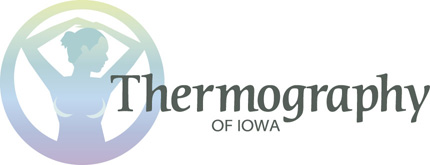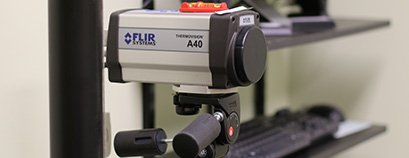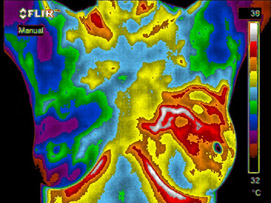

What is Thermography? A partner in early breast cancer detection.
Breast thermography has developed into an important tool in the fight against breast cancer. As a safe, comfortable, and sensitive procedure, thermography is used to detect infrared markers that may suggest some of the earliest signs of breast cancer. Thermography uses sophisticated infrared cameras and computer systems to image heat patterns from the surface of breasts. Alterations in these images are caused when cellular changes increase blood flow (angiogenesis); thus, warming the breast. These thermovascular changes may be among the earliest signs of breast cancer.
What does Breast Thermography have to offer?
- Some of the earliest signs that a breast cancer may be forming. Angiogenesis, or new blood vessel formation, is necessary to sustain the growth of a tumor. Breast thermography may be the first signal that such a possibility is developing.
- Individualized breast cancer risk assessment. Women with a family history are definitely at greater risk, but 75% of women who get breast cancer have no family history of the disease. If discovered, certain thermographic risk markers may warn a woman that she needs to work closely with her doctor to improve her breast health. Monitoring with regular check-ups, and thermography will look for improvements with time or possibly the earliest signs that a problem may exist.
- A possible role in breast cancer prevention. Since the single greatest risk factor for the development of breast cancer is lifetime exposure to estrogen, normalizing the balance of the hormones in the breast may be an important step in prevention. Certain thermographic signs may suggest the effect of hormones in the breasts. This may be the first marker that alerts your doctor to this possibility. Your doctor will first need to run further tests to confirm this. If these test are positive, your doctor may use these tests to monitor your care.
- Imaging for younger women. Do you know that approximately 15% of all breast cancers occur in women under 45? This is the most common cancer in women in this age group. Breast cancers in younger women are usually more aggressive and have poorer survival rates. Breast thermography offers younger women a valuable imaging tool that they can add to their regular breast health check-ups beginning with baseline imaging at age 20.
What makes Breast Thermography so unique?
- Thermography is an imaging procedure that uses no radiation, injections, or other invasive methods.
- Infrared markers of early stage cancers that are missed by other methods may be discovered with thermography.
- Women who are on hormone replacement, or have fibrocystic, large, dense, or augmented breasts pose no difficulties when it comes to the reading of thermograms.
- Since thermography does not involve contact with the skin, the procedure is quite comfortable.
- Studies show that an abnormal thermogram is the single most important marker of high risk for developing breast cancer; 10 times more that significant than a family history of the disease.

In the absence of other positive testing, an abnormal thermogram may give a woman an early warning that a pathological process may be occurring. By maintaining close monitoring of her breast health with the addition of thermography to her regular exams, a woman may have a much better chance of detecting cancer at its earliest stage and preventing invasive tumor growth.
About the Procedure
Once in the office, you will be asked to fill out a breast health history form. The procedure itself begins with a 15 minute temperature acclimation period. During this time you will be disrobed from the waist up while in a special temperature controlled imaging suite. Once acclimated to the temperature of the room, you will be placed in front of an infrared camera while multiple images are taken from different angles.
Early Detection Means Life
- Baseline thermograms at age 20
- 20-30 years of age – every 3 years
- 30 years of age and over – every year
Breast cancer is the most common cancer of women, and the risk increases with age. Risk is also higher in women whose close relatives have had the disease. Women without children, and those who have had their first child after age 30, also seem to be at higher risk. However, every woman is at risk of developing breast cancer. Current research indicates that 1 in every 8 women in the United States will get breast cancer in her lifetime.
It has been determined that no one method of examination alone will serve all the needs in early breast cancer detection. Thermography’s role is in addition to mammography not in lieu of. Thermography does not replace mammography and mammography does not replace thermography, the test complement each other. It is thermography’s unique ability to detect the abnormal heat and blood vessel changes produced by diseased breast tissue that allows for early detection. Since it has been determined that 1 in 8 women will get breast cancer, we must use every means possible to detect cancers when there is the greatest chance for survival. Proper use of breast self-exams, physician exams, thermography, and mammography together provide the earliest detection system available to date.
For more information visit: thermographyofiowa.com and breastthermography.com
To make an appointment call: 515-252-7688 or 888-799-5588
